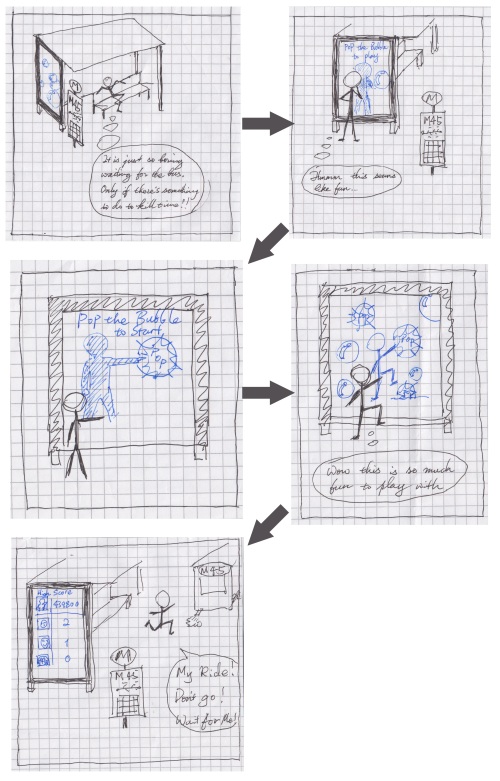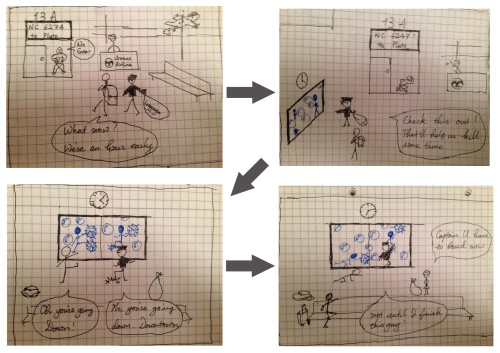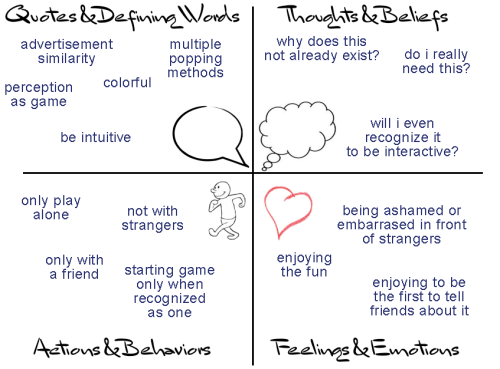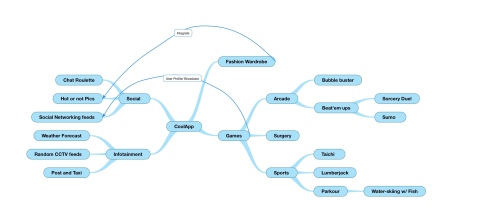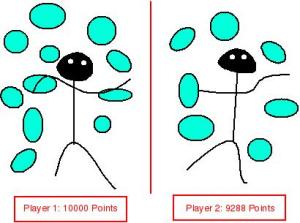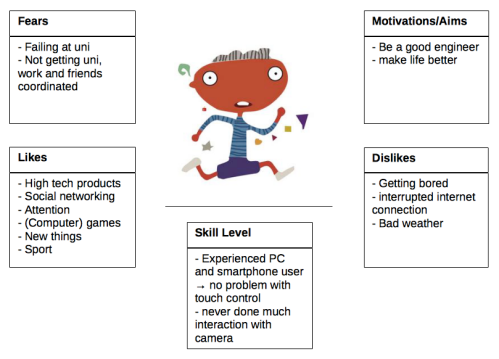Week 3/4 – Requirements, Storyboarding, Interviews
This time we actually had two weeks to do multiple things. First we had to come up with two different storyboards, simply describing possible contexts of our application. The prototypical idea still is to make waiting more bearable, maybe even fun. So our first storyboard is placed at a bus stop, where you could play our game on one of the public displays.
It’s not only waiting at a bus stop that’s annoying. If you are up to go on vacation and you’re waiting for your flight with your friend (or go to work as a pilot), you both could play the game to kill your time.
___
As a second task we had to thought about interview questions that we could ask potential users (of our target group) to get some feedback on our brainstormed ideas and the storyboards. So the following part will describe our detailed interview agenda.
First Part – Introduction (5 minutes):
1. Hi, we are students of TU Berlin and we are working on a project regarding new interaction possibilities in known environments. We would like to do a little survey with you which will take about 30 minutes. Is this alright?
2. Do you mind if we record the conversation?
3. Ok, first some general questions:
– Name
– Age
– Gender
– Occupation
– Email (for further stage in our iterative design)
Second Part – Daily life relating to application idea (10-15min):
1. How do you usually go to work/school?
– (by car/feet): Are you using public transport as well?
2. How long do you usually have to wait?
3. How long does it take you to become really annoyed?
4. If it takes long, how do you usually kill time?
5. What kinds of time-killer game do you suggest while waiting for the bus?
6. Would you be interested in some new ways of game interaction to kill your time?
7. Do you think in general people at your age are fast learners when it comes to games?
8. About how much time per week do you usually spend on playing games?
9. Do you have any experience with public games? (If so, which exactly?)
10. Do you have any experience with Microsoft Kinect or camera interaction in general?
Third Part – Application idea (10-15min):
0. Explaining the idea, showing storyboard.
1. Can you imagine playing this game and if not why?
2. What do you think about the tempting bubble in the beginning to lure the player into the game?
3. Which difficulty chooser method you liked most?*
4. Poking, clapping, squeezing, hit from the depth – which method would be more comfortable to destroy the bubbles? (or any other method?)**
5 .Can you imagine playing this with other people (also random people)?
6. Something you’d think we definitely should add?
7. Would you recommend this game to your friends, if it is available?
That’s it. Thank you very much for your time and insights. Here is a bubble for you./eoi
As an addition to the storyboards we have been discussing some features, were we wanted some feedback as well:
*We asked ourselves about the best method to choose different difficulty levels and we come up with some ideas:
- multiple (three) bubbles with an obviously different degree of thickness, meaning the thicker the bubble you pop to start the game, the tougher it will be
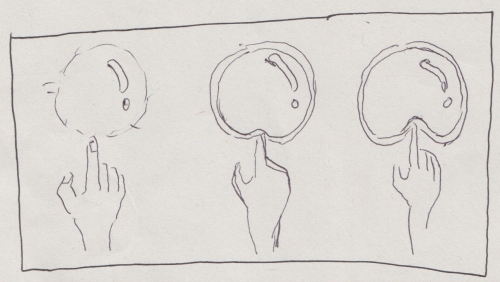
- multiple (three) areas on the screen with a different amount of bubbles you have to pop to start the game, indicating that there will be more bubbles in that particular game you have to pop making it more difficult in general
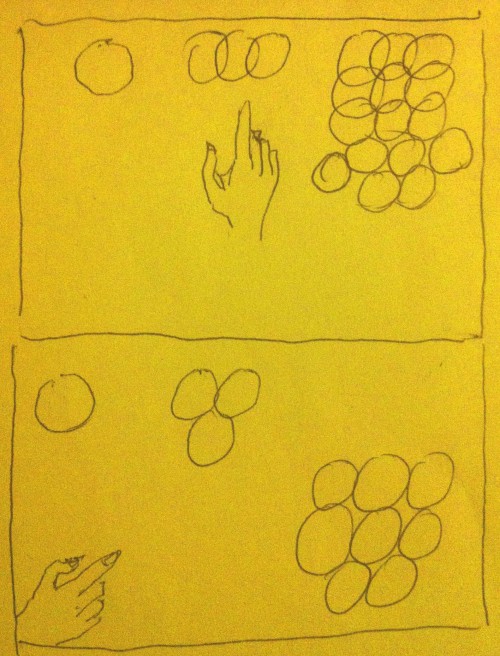
**Besides the problem of chosing different levels of difficulty the even more important question is how to acutally pop a bubble. Does it have to be really close to pop a bubble wrap or is it sufficient to pop it just like an air bubble?
- poking a bubble with a straight hand (or index finger alone)
- squeezing a bubble between thumb and rest of fingers
- hit from the depth
- clapping with both hands
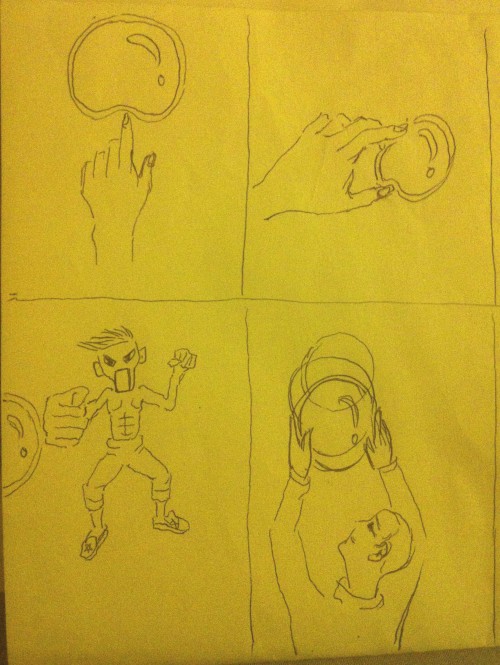
___
We met our three interviewees somewhere in the Matrix:
Neo is 25 and studies Computer Engineering at TU Zion. When he doesn’t want to fly to university he takes public transport.
Trinity is 23 and probably the best Spanish teacher in Zion. She has to take public transport every day to get to work.
Morpheus is 25 and studies Computer Engineering as well. To find the wisdom of the Oracle he has to take the bus every day.
They all own a smartphone, are socially well connected and public transport professionals.
___
To get a general feeling and to be really empathetic with our users, we created an Empathy Map:
___
Throughout the interviews we could gain very valuable feedback on:
How to destroy the bubble?
When asking the interviewees about the best method of popping the bubbles, all of them came up with the idea of switching the method from time to time, in order to make the game more fun. If they had to choose only one, the opinions on which method would work best for them varied from person to person.
Primary luring bubble?
The interviewees liked the idea of having a bubble in the primary stage of the interaction to lure the user into the game. One interviewee mentioned to be very careful on how this bubble interacts with the user, to not be mistaken with advertisement.
How to choose the difficulty level?
Further all interviewees liked the idea of choosing the difficulty level via bubbles differing in quality (like thickness).
Quick to understand?
In terms of understanding the game quickly, no one showed doubts that other people his/her age would be able to grasp the basic idea behind the game quickly.
Multiplayer compatible?
Another interesting insight was that the German interviewees were sceptical about playing this game on a bus stop with strangers, whereas the Spanish interviewee did see no problem in that. For the Germans two main questions led to their opinion:
- Do I really want to move funny in front of strangers?
- Would the screen be too chaotic, so that proper game interaction would become more difficult?
___
Considering the interview results we came up with three design principles:
- Our game should be intuitive and diverting.
- Popping a bubble should be possible in multiple ways to prevent boredom even after several rounds.
- The game has to be recognized as one and not to be confused with an advertisement.
___
Task Breakdown:
Karl – Storyboarding, Interview Questions, Interviews, Interview Results, Writing Blog
Ray – Storyboarding++, Interview Questions
Richard – Storyboarding, Interview Questions, Interviews, Empathy Map, Writing Blog++
Yvonne – Storyboarding++, Interview Questions
